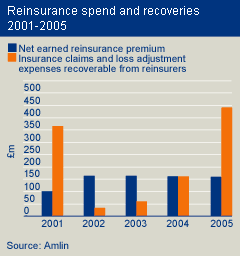Amlin's Katrina experience
Hurricane Katrina was a major test of our catastrophe management capabilities.The hurricane was extraordinary due to its size and severity as well as its track over New Orleans that eventually led to the breach of levees and catastrophic flooding of the city.
It affected a number of classes of Amlin's business with claims arising from damage to energy installations in the Gulf of Mexico, damage from wind and flood to large commercial property in New Orleans and Mississippi, and claims on property reinsurance and catastrophe reinsurance programmes for clients with their own exposures in the area.
The table below illustrates the sources of the loss and compares it to our modelled US$60 billion Gulf of Mexico hurricane realistic disaster scenario ("RDS").
| Comparison of Gulf RDS to Hurricane Katrina |
Class |
Katrina claim US$m |
RDS
claim
|
Difference
US$m |
 |
| Catastrophe reinsurance |
175 |
281 |
-106 |
 |
| Property reinsurance |
85 |
38 |
47 |
 |
| Property insurance |
217 |
65 |
152 |
 |
| Energy |
32 |
92 |
-60 |
 |
| Marine reinsurance |
7 |
13 |
-6 |
 |
| Other |
11 |
16 |
-5 |
 |
| Gross claims |
527 |
505 |
22 |
 |
| Reinsurance recoveries |
-429 |
-392 |
-37 |
 |
| Net reinstatement premiums |
6 |
-9 |
15 |
 |
| Total |
104 |
104 |
0 |
 |
|
Overall, the estimated gross loss was remarkably close to our modelled event loss, although as can be seen above, the property insurance and reinsurance losses were higher than modelled and other classes were less than modelled.
The loss emanating from the property insurance portfolio was greater than envisaged due to the severe surge and flood losses to commercial property. As explained above the models employed did not cater well for these eventualities. Conversely our modelled event had a more severe impact upon the gulf energy installations than the actual Katrina event because the wind path of the storm passed over a lower concentration of values.
What is also clear from the loss numbers is the extent of reinsurance protection that we had last year to reduce the volatility from such extreme events.
Reinsurance purchase
We have used reinsurance to protect the business from volatility caused by either an extraordinarily large or a high frequency of major loss events. It is typically purchased to protect specific class exposures and to protect against catastrophes.
Following the events of the last two years, which have resulted in very significant losses for retrocessional reinsurers in particular, the amount of available retrocessional capacity has diminished and the price for such cover has increased dramatically.
In these circumstances, we have so far chosen not to purchase retrocessional reinsurance although we have renewed most of our direct reinsurance programmes. We are reducing peak catastrophe exposures and have used Amlin Bermuda to reinsure Syndicate 2001 so that it remains within the risk appetite agreed with Lloyd's. This has been possible, whilst containing Amlin Bermuda's exposures within the originally set limits, as Amlin Bermuda, whilst in start up mode, is not fully utilising its exposure limits on directly written business. Higher inwards premium and the resultant cost savings from this approach also help compensate for the higher risk. This situation is being kept under close review so that, in advance of the 2006 windstorm season, our net exposures remain within levels where we do not expect to be over exposing the balance sheet after taking account of profits capable of being generated in non catastrophe exposed areas.
 |